Cisco Nexus Dashboard Insights and Panduit Intelligent PDU Integration Solution Overview
Available Languages
Bias-Free Language
The documentation set for this product strives to use bias-free language. For the purposes of this documentation set, bias-free is defined as language that does not imply discrimination based on age, disability, gender, racial identity, ethnic identity, sexual orientation, socioeconomic status, and intersectionality. Exceptions may be present in the documentation due to language that is hardcoded in the user interfaces of the product software, language used based on RFP documentation, or language that is used by a referenced third-party product. Learn more about how Cisco is using Inclusive Language.
Rising energy and material costs, escalating power requirements, and impending regulations have intensified the compelling customer needs surrounding sustainability for data centers. Data-center operators must support growing compute and network demands from applications such as AI/ML, while ensuring availability for successful business outcomes.
According to the International Energy Agency (IEA), data centers consume 1 percent to 1.3 percent of the total electricity used globally, and data-center energy consumption is growing at 10 percent to 30 percent per year. At the same time, countries are grappling with limited energy availability and, in turn, are limiting the power available to data centers. Data centers and data-transmission networks also account for nearly 1 percent of energy-related global Greenhouse Gas (GHG) emissions (source: IEA).
This makes it imperative for data-center operators, not only to optimize energy usage and cost to meet their business needs, but also to implement effective sustainability strategies to mitigate environmental impact.
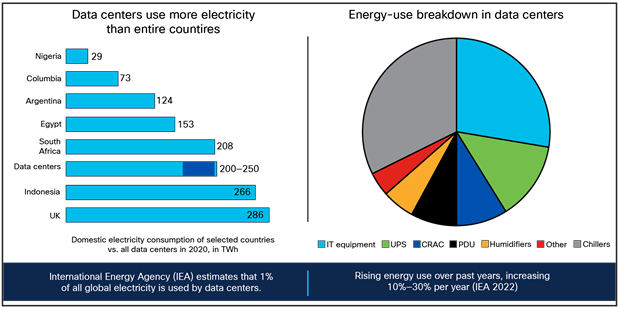
International energy agency data
To build sustainable data centers, real-time visibility of energy consumption, workload, and resource optimization is paramount. Visibility of both IT (network, compute, storage, applications, etc.) and facilities (systems such as power, uninterruptible power supplies, etc.) technologies is critical to managing energy usage and ensuring availability for data centers. According to The Uptime Institute Global Survey of IT and Data Center Managers (2020–2022), power and the network outages account for 58 percent data center outages.
However, infrastructure management for IT and facilities assets are becoming more complex, diverse, and distributed, with multiple configuration points, monitoring tools, and vast amounts of data generated every second. Further, IT and facilities assets and management tools are often managed by different teams within an organization, leading to information siloes and suboptimal planning and coordination.
● Visibility into data-center IT equipment energy consumption and cost.
● Insights into carbon footprint Greenhouse Gas (GHG) emissions of managed devices.
● Key sustainability metrics that help identify key impacting devices.
The solution: Making sustainability actionable and simple
The integration of Panduit Intelligent Power Distribution Units (iPDUs) with Cisco Nexus® Dashboard simplifies data-center operations by bringing real-time sustainability insights to operators and by unifying IT and facilities data points into a single pane of glass. As a result, data-center operators will gain visibility at a site, equipment, or PDU outlet level with actionable insights to reduce energy usage and costs and to optimize their sustainability strategies.
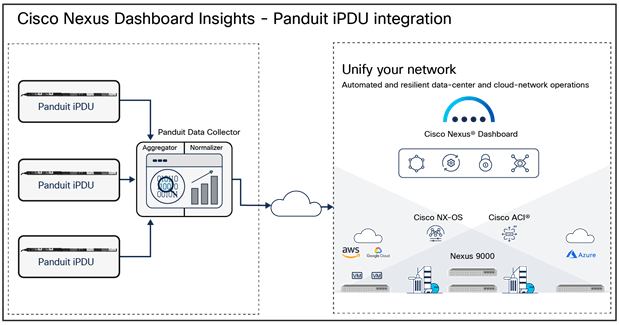
Solution architecture
Panduit iPDUs offer comprehensive power-monitoring information, from single-phase or three-phase systems down to individual device levels. It measures both input power for the entire iPDU and outlet-level power for granular insight.
This data is seamlessly accessed by Panduit’s Data Collector, a lightweight software, deployable in a Virtual Machine (VM), Linux device, or Raspberry Pi. The Data Collector has two components:
● Aggregator: Pulls data from multiple Panduit iPDUs through a secure SNMPv3 protocol.
● Normalizer: Packages data for transmission and pushes it to Cisco Nexus Dashboard through a RESTful API.
Communication between the Data Collector and Nexus Dashboard is established after an authentication and token exchange takes place through a separate RESTful API.
Table 1. Hardware and software components
| Product |
Description |
| Cisco Nexus Dashboard |
Cisco Nexus Dashboard is a unified operations platform that hosts best-in-class capabilities to empower operations teams. https://www.cisco.com/site/us/en/products/networking/cloud-networking/nexus-platform/index.html. |
| Panduit intelligent PDU |
Panduit Intelligent PDUs (iPDUs) monitor data-center power usage and the environment by continuously scanning for electrical circuit overloads and physical environmental conditions that place critical IT equipment at risk. |
| Panduit Data Collector |
The Panduit Data Collector collects and relays power data from Panduit iPDUs to Cisco Nexus Dashboard. https://www.panduit.com/en/support/download-center/power-distribution-units.html. |
Use case: Real-time and historical visibility and insights
By integrating Panduit iPDUs with Cisco Nexus Dashboard, customers gain visibility into real-time and historical energy consumption, energy costs, and GHG emissions across all the devices in a data center. They can quickly understand past performance, forecast future energy requirements, and monitor their progress on net-zero initiatives.
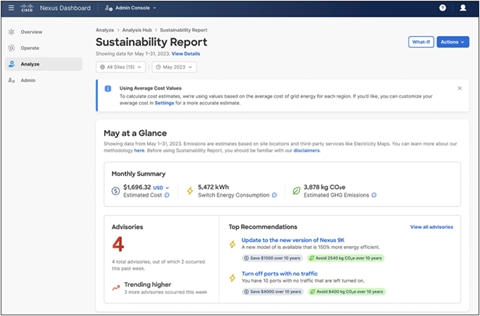
Monthly dashboard for data-center energy costs, usage, and emissions data
Use case: IT equipment-level data for device optimization
Panduit Intelligent PDUs with outlet-level monitoring enable Nexus Dashboard customers to have granular visibility into IT equipment, such as switches, servers, storage, or any other device connected to an iPDU. Customers will now have greater insights into key sources of energy consumption, cost, and GHG emissions within their data centers, identify anomalous devices, and make necessary upgrades of equipment to optimize energy consumption.
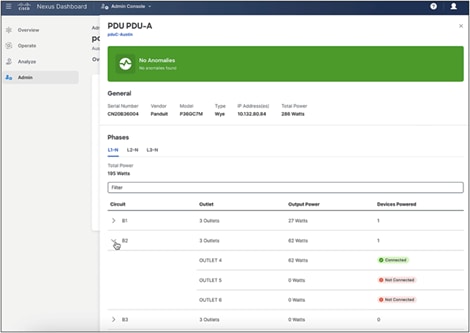
Detailed data for onboarded Panduit iPDUs
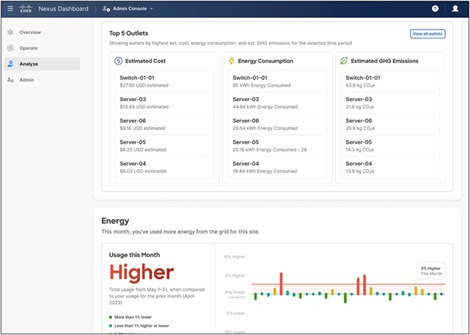
IT equipment-level data covering energy cost, usage, and emissions
Through the integration of IT and facilities technologies, there is an opportunity, not only to enable sustainability objectives, but also to drive greater efficiencies in day-to-day operations for network and power, such as issue resolution and capacity planning.
With a long history of collaborating on network infrastructure and our extension into power and sustainability, Cisco and Panduit are uniquely positioned to help customers not only deliver resilient and highly scalable data centers, but also the visibility and actionable insights needed to accelerate their sustainability journey
Accelerate your sustainability journey today
Please connect with your Panduit, Cisco, or partner contact to learn more. Useful links:
● www.cisco.com/go/nexusdashboard
● www.panduit.com/panduitciscoalliance